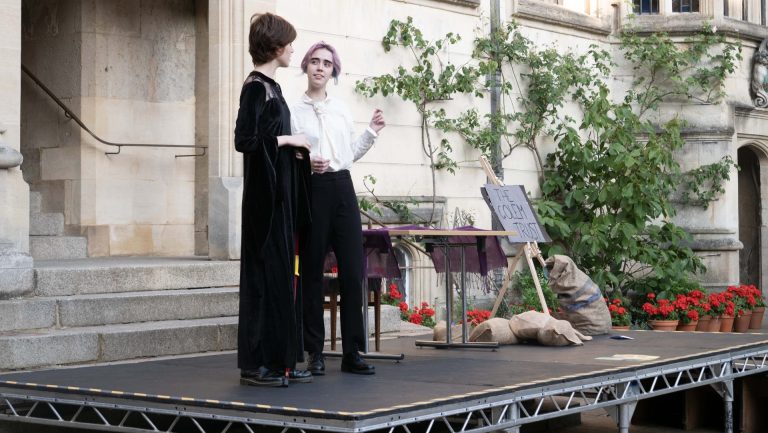Over the last year, universities have become flashpoints of protest and backlash. Student protest is nothing new, but the heavy-handed government response is notable. In the US, President Donald Trump’s administration has utilised the federal government’s power against higher education institutions, particularly those in the Ivy League. Spending cuts, attempts to deport international students, and allegations of civil rights violations have all been leveraged to influence the way universities work. Much of this has been in reaction to pro-Palestine protests, as well as a broader right-wing suspicion of university ‘indoctrination’.
Far-right figures in the country echo a Trumpian attitude to ‘woke’ universities, and high-profile protests have taken place in the UK. So, is the state of higher education in the US a sign of things to come for the UK, and for Oxford? Will similar tensions translate to similar government action, and similar university response?
Existing tensions
Universities have long been a target of the far right, with familiar claims made on both sides of the pond: that they are places of indoctrination, that they are inhibiting free speech, and that they are being ruined by diversity initiatives. Allegations of anti-semitism on campus, in relation to pro-Palestine protests, have also been raised.
In a climate of rising anti-intellectualism, British institutions have not been exempt from these accusations. Nigel Farage, the leader of Reform UK, has suggested that anyone who is an EDI officer should “look for another job”. Zia Yusuf, Reform’s head of policy, similarly stressed that universities had become “indoctrination camps”. This echoes Trump’s attack on higher education diversity initiatives, and marks deepening ties between the British far-right and the MAGA movement.
One of the most prominent voices in this special relationship is James Orr, the associate professor of philosophy of religion at the University of Cambridge, who has been considered the “intellectual mentor” of US Vice President JD Vance. Orr is an outspoken critic of the “dogmas of EDI” that, in his words, “distort decision-making at every level of the modern university”.
The 19-year-old Warwickshire County Council leader George Finch recently accused universities of being “conveyor belt[s] of communism” where students are taught a “coercive curriculum”. Finch, who chose not to pursue any education beyond sixth form, argued that “you’re being told what to think, you’re being told what to say”.
I spoke to Annelise Orleck, a history professor at Dartmouth College, about the current crisis facing universities. She rejected the accusation that she is indoctrinating her students: “We teach our students how to think, [we] give them critical tools to think and ask questions in ways that make the current powers that be uncomfortable.” Orleck, who has taught at Dartmouth for over three decades, reflected that there were problems facing higher education, but they were not the ones being identified by the far right: “It has been said of universities, even before Trump took over, that they are… hedge funds and weapons portfolios with a sideline in education, so they can write all that off in their taxes.”
The crisis
Widespread student protests in both the UK and the US have set these tensions alight. On International Workers’ Day, 1st May 2024, faculty members joined Dartmouth students at a pro-Palestine protest. In the rural New Hampshire town of Hanover, state police were called to break up the demonstration. As Orleck, the former chair of the Jewish Studies department, took out her phone to record the protest, an officer slammed her to the ground. Her arrest, caught on video, went viral.
Recalling the night of her arrest, Orleck said that the protesters “had no idea what was beginning”. In Orleck’s words, she was arrested for “trying to fulfil [her] responsibilities as a teacher and protect [her] students”. She considered that the experience “marked the beginning of this assault on peaceful protest and freedom of expression on our campus and on many campuses across the country”.
Trump’s pledge to “fire the radical-left accreditors that have allowed our colleges to become dominated by Marxist maniacs and lunatics” culminated in a battle between the administration and the United States’ oldest university, Harvard. In April 2025, $2.2 billion in funding was frozen by the government as the President demanded that Harvard be audited to assess the “programs and departments that most fuel antisemitic harassment or reflect ideological capture”. In response, Harvard sued the administration.
The State Department revoked the visas of around 300 international students (as of April 2025), and attempted to block Harvard from enrolling more. The administration has also used its financial power over universities, cutting diversity-related research grants while offering a preferential funding plan to all universities and colleges that adopt certain policies. They involve requiring ‘single-sex spaces’, capping undergraduate visas at 15% or less, and abolishing units that “punish” or “belittle” conservative ideas.
In the same month as the Dartmouth protests, Oxford Action for Palestine (OA4P) set up encampments at the Natural History Museum and the Radcliffe Camera. The University threatened legal action if they didn’t leave, a move that Cambridge had already pursued. A few weeks after the arrest of 89 students and staff at Dartmouth, 17 student protesters were arrested in a pro-Palestine sit-in at Wellington Square. Thames Valley Police have since dropped the charges, and the University recently stopped disciplinary measures against the students.
While far-right rhetoric against universities is intensifying, government action has not yet followed, and certainly not to the extent seen in the US. The Labour government has not publicly criticised any universities, nor used its powers to intervene into university matters. No matter what Reform says, the party is not in power. No matter how strongly it states its stances, it cannot match the firepower of the Trump administration because it does not have access to its tactics. Even if it did, they may prove less effective against Oxbridge. Oxford’s colleges are financially autonomous of the University, and the University itself has independent sources of income, like research and donations. But with 36% of undergraduates admitted in 2024 being international, Oxford is similarly vulnerable to a crackdown on visas. This presents an ominous picture for what may happen if Reform do as well as they are projected to at the next election (projected to be the largest party, but 25 short of a majority). Much depends on how universities and other institutions choose to respond to governmental pressure.
Response
In response to increased government crackdown, US colleges quickly sprang to Harvard’s defence. Over 600 institutions signed an open letter from the American Association of Colleges and Universities (AAC&U) as “one voice against the unprecedented government overreach and political interference now endangering American higher education”. Calling for “constructive engagement”, the letter demanded the protection of their shared ideal of the “essential freedom to determine, on academic grounds, whom to admit and what is taught, how, and by whom”. All Ivy League colleges signed the letter, except Dartmouth.
Sian Beilock, the President of Dartmouth, defended her decision in an email to students and faculty, claiming that open letters are “rarely effective tools to make change”. Two years prior, she signed an open letter as president-elect to support diversifying the semi-conductor industry. Dartmouth, unlike its peers, has continuously stressed their neutral position, staying away from the political limelight. “We can do better by staying focused on what we are: educational institutions, not political organisations”, wrote Beilock. The exact same rhetoric was employed during her address to the matriculating Class of 2029: “We’re not a political organisation.”
Beilock’s actions gained praise from conservatives and members of the Trump administration. Despite claims of neutrality, the former chief counsel at the Republican National Committee, Mathew Raymer, has been appointed as Dartmouth’s Senior Vice President and General Counsel. In an op-ed titled ‘Trump Is Right About Birthright Citizenship’ in The Federalist, he argues that children “born to aliens” should not have birthright citizenship. As the new head of the college’s Office for Visa and Immigration Services, this calls into question how apolitical Dartmouth truly is.
Dartmouth has yet to face direct funding cuts, unlike other elite colleges, such as Columbia and Cornell. For supporters of Beilock, her unprovocative strategy towards the Trump administration has paid off. The college’s international students have by and large avoided becoming the next target of the administration – as long as they don’t protest.
When I asked Orleck about Beilock’s actions, she said it seemed to be a “strategic decision”, however, she added that “collaborating with fascism, in the end, is never a good idea”. Perceived as having perpetrated a betrayal against Dartmouth’s Ivy League peers, close to 3000 alumni condemned Beilock’s refusal to sign the AAC&U letter in a petition.
“Appeasement can feel safe and easy – if that means giving in to the demands either of student protesters or of vocal donors”, wrote Beilock in The Atlantic in September 2024. It is difficult to overlook the irony at play. Choosing the “safe and easy” option, Dartmouth appears to have appeased the Trump administration.
But the power of the administration was not unlimited. Judge William G Young considered that the Trump administration had acted unlawfully in its deportations. In a September ruling, the Massachusetts federal judge held that non-citizens hold the same free speech rights as citizens under the US constitution, and that the targeted deportations infringed upon this right. Similarly, Judge Allison Burroughs overturned Harvard’s funding freeze. The administration is appealing both cases, and much will hinge on the pro-Trump Supreme Court’s treatment of the issue. These rulings suggest that the bark of government pressure does not always match its bite. Appeasement may be an unnecessary step in the long run.
Oxford impact
As the far right’s potential assault on higher education in Britain looms large, we must then ask: how has Oxford acted in the face of an increasingly global threat to higher education? Unlike Dartmouth’s decision to stay under Trump’s radar, cowing to the administration’s demands at the cost of academic integrity and the safety of their students and staff, British institutions must not merely protect their reputations but fight to ensure our institutions foster a diverse and inclusive culture.
In response to the protest that took place in Oxford, eleven Jewish faculty members wrote an open letter to the Vice Chancellor and the Chief Diversity Officer, urging the University to “drop disciplinary proceedings…against the 13 students who occupied Wellington Square”. The signatories pushed back against the idea that pro-Palestine actions in Oxford were related to antisemitism, saying: “antisemitism is a serious and ongoing threat, but there is no credible evidence that the encampment, in which Jewish students were also actively involved, led to a rise in antisemitism or that it was experienced in a uniform way by Oxford’s highly diverse Jewish community.”
In Dartmouth, Orleck echoed the sentiment in the letter, arguing that “the problem is weaponizing antisemitism as an excuse for cracking down on speech and speech rights and the right to peaceful protest”. Orleck said: “We’re in a dangerous moment of repression and as a Jewish woman…and a Jewish Studies scholar and a Jewish historian, I find it really, really frightening that it’s being done in the name of protecting against antisemitism.”
The University of Oxford’s Chief Diversity Officer, Tim Soutphommasane, has made it clear that “the UK is not the US”. Recognising this distinction, he says, is “a critical starting point for any approach we have. And we should be very mindful of allowing culture war excesses from the US contaminating the public culture here”. He has warned that British universities “can’t be sucked into a vortex of culture war politics”, arguing that “public institutions in the UK, including universities, have an important role in promoting equality of opportunity and social understanding”.
Last year, Oxford launched the Equality, Diversity and Inclusion Strategic Plan as the institution “strive[s] to be a leader on equality, diversity and inclusion in society”. Addressing the four areas of culture, diversity, work and leadership, the plan seeks to “strengthen a culture of belonging”, “increase staff and student diversity and representation”, “ensure teaching, research and engagement practices are inclusive” and “support academic and professional leadership”. Clear targets were outlined, including increasing the proportion of BME and female professors. Working alongside the LGBTQ+ group, a racial and religious inclusion ‘task and finish’ group was established. More work is clearly necessary to see improvements within Oxford, but the administration’s dedication to EDI initiatives provide a stark contrast with Dartmouth’s appeasement in the face of government pressure.
Where next?
“I’m constitutionally optimistic”, Orleck said wryly when I asked her about the future of higher education. Nonetheless, I am unconvinced that she has faith in her optimism. Her attempt to remain positive does not seem successful: “I want to be a purveyor of radical hope. That said, I and everybody else I know… is very worried.”
The UK often feels shockwaves from political actions in the US, but the difference between Dartmouth and Oxford’s reaction to increasing anti-diversity rhetoric shows that there is still a place for resistance. The outcome of cases brought by universities provide a chance for optimism, and a reason against immediate appeasement. As universities brace for what may be an existential threat, let us only hope that Oxford can one day become a “purveyor of radical hope”.
Image Credit: Kenneth C. Zirkel, CC BY 4.0 via Wikimedia Commons














